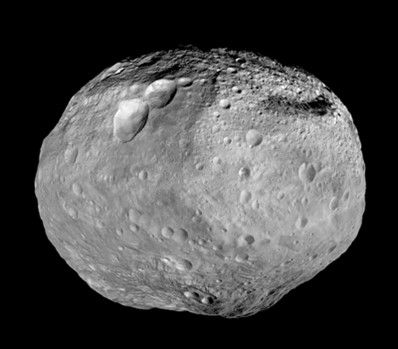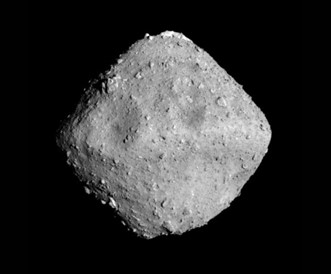by Rida Fatima

(Figure 1: Asteroid moonlet Dimorphos as seen by the DART spacecraft 11 seconds before impact. DART’s DRACO imager captured this image from a distance of 42 miles (68 kilometers). This image was the last to contain all of Dimorphos in the field of view. Dimorphos)
Since asteroids preserve a history of our solar system’s past 4.6 billion years, many international researchers have dedicated their efforts to investigating them. Researchers can get knowledge about how our solar system developed into the Sun and planets we see today by studying asteroids, as well as how asteroid strikes can influence us in the long term.
A rock which descends to Earth from outer space is the fundamental definition of an asteroid. Although asteroids are rocks, they differ from rocks on Earth. The majority of these asteroids are far more ancient, and thus offer some of the sole specimens scientists possess of distant solar system bodies, including asteroids, meteors, as well as other planets. Even minuscule fragments that developed around different stars that originated before our Sun are found in certain asteroids.
Stardust, which is found in certain asteroids, was created by stars that existed before our own Solar System came into being. Research into such pre-solar particles can help us better grasp how stars begin and evolve. The earliest solidified substance to develop within our solar system can be found in some so-called “primitive” asteroids. The age of this substance, 4.568 billion years, has been used to calculate the age of our very own planetary system. Several ancient asteroids haven’t altered much at all since they were created, providing us with a glimpse into the ancient solar system’s environment.
Because organic substances like carbonyl compounds, complex amino acids, aliphatic amines, acetic acid, and formate could travel considerable distances within space debris, it is possible that asteroids carried the building blocks for life to Earth. Huge asteroids can cause massive extinction events and alter the trajectory of our existence on Earth. One such asteroid hit 65 million years ago and infamously wiped out the dinosaurs.
In a new research, a big, multinational team employed the UK’s national synchrotron facility, Diamond Light Source, to analyze particles retrieved from a near-Earth asteroid to increase our knowledge of the history of our planetary system.

(Figure 2: The asteroid Ryugu, as seen by Japan’s Hayabusa2 spacecraft on June 26, 2018. (Image credit: JAXA, University of Tokyo, Kochi University, Rikkyo University, Nagoya University, Chiba Institute of Technology, Meiji University, University of Aizu, AIST))
A specimen of fragments collected from the Ryugu asteroid was brought to Diamond’s Nanoprobe beamline I14 by scientists from the University of Leicester. There, a specialized method known as X-ray Absorption Near Edge Spectroscopy (XANES) was employed to plot the chemical states of the elements present inside the asteroid contents and investigate its constituents in considerable depth. The research group also analyzed the asteroid’s contents with the help of an electron microscope at Diamond’s electron Physical Science Imaging Centre (ePSIC).
Julia Parker is the Principal Beamline Scientist for I14 at Diamond. She said:
“The X-ray Nanoprobe allows scientists to examine the chemical structure of their samples at micron to nano length scales, which is complemented by the nano to atomic resolution of the imaging at ePSIC. It’s very exciting to be able to contribute to the understanding of these unique samples, and to work with the team at Leicester to demonstrate how the techniques at the beamline, and correlatively at ePSIC, can benefit future sample return missions.”
The information gathered at Diamond helped researchers better understand the asteroid’s signs of space weathering. The researchers were able to investigate how cosmic aging could change the morphological and molecular content of the surfaces of carbon containing asteroids like Ryugu thanks to the pure asteroid specimens.
The dehydration of Ryugu’s crust was observed by the researchers, and they concluded that space weathering is almost certainly to blame. According to the report’s results, which were just released in Nature Astronomy, asteroids that seem barren on the exterior might actually be water-rich, which could force us to revise current theories about the relative abundances of different sorts of asteroids and the origin of the asteroid belt.
Ryugu, a near-Earth asteroid with a diameter of about 900 meters, was found for the first time in the asteroid belt between Mars and Jupiter in 1999. It is called after the Japanese mythological underwater temple of the Dragon God. In order to interact with the Ryugu asteroid and gather mineral specimens from its exterior and interior, the Japanese state space agency JAXA deployed Hayabusa2 in 2014. In 2020, the spaceship made its way back to Earth and released a container carrying valuable asteroid pieces. These tiny specimens were dispersed to different laboratories worldwide for analytical investigation, such as the School of Physics & Astronomy at the University of Leicester and Space Park, where John Bridges, one of the paper’s writers and a professor of planetary science, works.
John stated:
“This unique mission to gather samples from the most primitive, carbonaceous, building blocks of the Solar System needs the world’s most detailed microscopy, and thats why JAXA and the Fine Grained Mineralogy team wanted us to analyse samples at Diamond’s X-ray nanoprobe beamline. We helped reveal the nature of space weathering on this asteroid with micrometeorite impacts and the solar wind creating dehydrated serpentine minerals, and an associated reduction from oxidised Fe3+ to more reduced Fe2+.
It’s important to build up experience in studying samples returned from asteroids, as in the Hayabusa2 mission, because soon there will be new samples from other asteroid types, the Moon and within the next 10 years Mars, returned to Earth. The UK community will be able to perform some of the critical analyses due to our facilities at Diamond and the electron microscopes at ePSIC.”
In the ancient Solar System, before Earth formed, water, rocks, and organic material interacted to generate the basic components of Ryugu. The formation of the initial solar system and the later formation of the Earth could both be better understood by comprehending the makeup of asteroids. Given that asteroids are thought to have brought most of the planet’s water as well as biochemical compounds like amino acids that serve as the basic components from which all human life is built, they also might aid in understanding how life on this planet first originated. We would be able to properly comprehend the history of life itself as a consequence of the data being gathered from such small asteroid fragments. A device that is 10,000 times stronger than a conventional microscope can be used by researchers at the synchrotron to examine their specimens, whether they are bits of asteroids or unidentified viral complexes.
References
1. Noguchi, T., Matsumoto, T., Miyake, A. A dehydrated space-weathered skin cloaking the hydrated interior of Ryugu. Nat Astron, 2022 DOI: 10.1038/s41550-022-01841-6
2. Diamond Light Source. “Ancient asteroid grains provide insight into the evolution of our solar system.” ScienceDaily. ScienceDaily, 19 December 2022.
3. https://en.prothomalo.com/science-technology/science/tryxskiue0
4. Arizona State University meteorites.asu.edu. Retrieved on 20 June 2018.
5. American Museum of Natural History amnh.org. Retrieved on 20 June 2018.
6. https://www.amnh.org/exhibitions/permanent/meteorites/meteorites/what-is-a-meteorite
